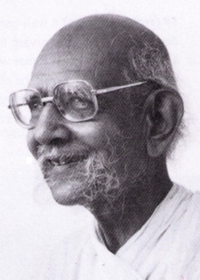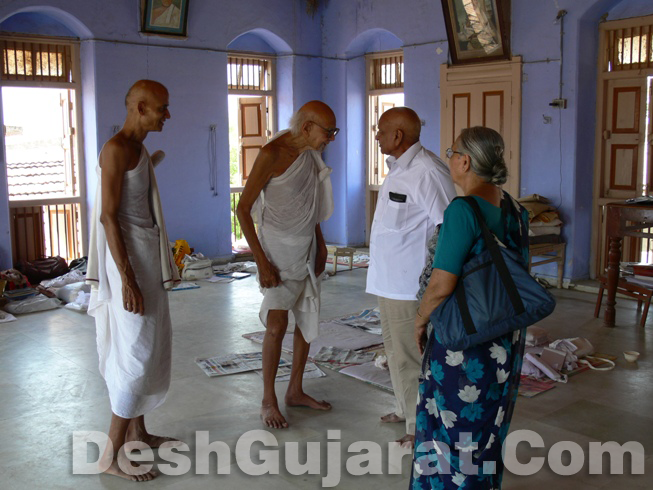 | Early morning, November 12, 2009 - Thursday, Muni Shri Jambu Vijayji was traveling on foot along with other monks from Balotra (a town in Rajsthan) to Jesalmer and they were hit by a high speed truck. Two munis, Jambuvijayji and Namaskarvijayji died in the accident and others are seriously injured. Jambuvijayji was 87 years old. | |
| Muni Jambu Vijay |

by Somchand Shah
Ahmedabad, DeshGujarat, 14 November, 2009
Author Somchand Shah is seen with Shri Jambu Vijayji Maharaj Saheb. This picture was taken at Mandal when the author, his wife and a scholar from Vienna Dr. Muroya visited Muni Shri Jambu Vijay.
Last year when I went to meet 86-year old Jambuvijayji at Patan, he was learning German language. When I curiously asked why he was learning German, he replied he was learning it to study lots of literature that he was receiving from German scholars.
There was a unique thing about Jambu Vijayji’s learning and teaching process. When he wanted to teach something to a scholar visiting him, he would seat higher. But when he wanted to learn something from the scholar, say a foreign language, he would make the foreign scholar seat on a height. It is Indian tradition that Guru always seats on a seat and a person who has come to Guru to learn something from him seats on floor. Jambuvijayji was so humble to seat on lower place when he wanted to learn something from a scholar visiting him. That is how he mastered about 22 languages - Gujarati, Hindi, English, Sanskrit, French, German, Sinhali, Tibetian, Japanese etc.
Once he told me that he needed a watch with radium marking so that he could watch the time even in dark. I was astonished as this monk never asked for anything from anybody, so this time when he asked me for something, I pleasantly felt a duty to fetch a watch for him at the earliest moment and I along with my father brought a watch with radium marking for him from Japan. But before me, someone else from Israel had already arranged it. When I along with my father requested Maharaj Saheb to accept the watch that we had brought for him, he refused to take it. He said he was a monk who had to walk with whatever he possessed. He, a Parivrajak could not accept even 1 gram thing more than actually needed. He was so desireless, selfless(nispruhi) that he refused to accept Acharyapada when offered. When Ahmedabad’s L.D.Institute of Indology prepared Abhinandan Granth(a volume) on his completion of 60 years as monk, he refused to include an article on him in that volume. Thus the volume was published without an article on Jambuvijayji.
Contrary to recent trend of urban savvy Jain monks, Shri Jambuvijay would always prefer to spend majority of his time in rural areas. He always preferred to halt in village so that large amount of visitors would not disturb him frequently in his reasearch work. He used to select a place where Jain Upashraya and Jain Mandir are located side by side, so that he and his mother would be able to have darshan every day in morning. He would also check whether the village is well connected through pucca road or not. Once when he was in Nakoda, he said me to come there. He said in Nakoda, clean and pure air of Rs. 1000 a kilo is available for free. Stay here for a week and you will not need to take medicine for year.
In last 10-12 years Shri Jambu Vijay Maharaj spent his Chaturmas(four-month period every year during which Jain monk would limit himself at one place) in areas around Shankheshwar. I remember one place - Surel where his 3.00 pm discourse was attended by all the village people, most of them non-Jains. It was like shut-down in whole village to listen to Maharaj Saheb.He lastly decided to spend Chaturmas periods in villages of his Diksharthi disciples. His next Chaturmas was scheduled at Mandsor(Madhya Pradesh) as Namaskar Muni who died with him in accident was from Ratlam. His visited Dhanpura village in recent past for Diksha of a Rajput boy. As Dhanpura is located just 11 km away from Dethali, we requested Maharaj Saheb to visit Dethli. And he replied that for saisari people it’s easy to push accelerator of a vehicle, but for Jain monks, the life is on legs, and the monks have to do many important things. When Jambuvijayji visited Badrinath in northern Himalayan area, the military people stationed there were amazed to know how a person could walk 3,000 kms in old-age barefoot to Himalaya from Gujarat!
Jambu Vijay Ji was not in favor of building new and newer Jain Mandirs here and there. He was also not in favor of throwing money during Varshidan procession. Once he said, Swami Vatsalya was meant to visit poor houses and distribute food or needed things there, so that really poor people would be happy and bless the Diksha ceremony. In typical Varshidan nowadays, only those who are powerful grab the money.
What made Jambu Vijayji a distinct monk was his humbleness, his exploration of knowledge and his zeal to share his knowledge. And pillars of this richness of characteristics were piled by Jambu Vijayji’s father, a Jain monk who was also his Guru. Jambu Vijayji’s sansari name was Manibhai and his father’s sansari name was Bhogibhai. Bhogibhai was from north Gujarat’s Dethali village. Bhogibhai was born in Mandal and later settled in Ahmedabad’s Ghanchini pol from where he left sansari life to become monk. Chinubhai(Jambu Vijayji Maharaj) was born in Zinzuvada, his mother Maniben’s native place. Chinubhai became Jambu Vijay Maharaj when he was 14. His diksha took place in Ratlam. When Jambu Vijayji spent his first chaturmas at Zinzuvada, his father and Guru managed a teacher to teach him English. Learning English made Jambu Vijayji a distinct one among Jain monks. Jambu Vijayji’s father became monk in 1932 and he died in 1960, but during this 28-year long period he trained Jambu Vijayji like anything.
During one of the discussions that took place between us he told that sum and substance of all religions is always in serving parents with at most regard and respect. He was a believer of the fact that a philosophy of Jain monk is to study, learn and guiding those who have desire to study, to learn. In letter and spirit he was a learned and a learner.
To become vegetarian is next to impossible for a person born and living in country like Japan. But he was Jambu Vijay Ji who made a Japanese scholar Shin Fujinaga a vegetarian. Fujinata first met Jambu Vijayji in 1982 and he was frequent visitor to Maharaj Saheb in all these years. He has Jain monk’s daily usage objects there in his house in Japan. Fujinata is actually a telecom engineer. He is involved in Japan Jain Sangh activities. Jambu Vijayji’s last foreign disciple Hiroko is still here in Gujarat. She is here for her scholarly work about Buddhist manuscripts.
Maharajshri’s greatest contribution has been in the area of preservation of ancient treasure of knowledge that lies in manuscripts. Whether it is Patan or Khambhat or Jaisalmer, due to Jambu Vijay Maharaj’s dedicated efforts and guidance, thousands of manuscripts are scanned, photocopied and preserved for future generations.
When Punyavijayji Maharaj Saheb passed away, Late Sheth Shri Kasturbhai said that his work would be carried out further aheaed by none other but only Shri Jambu Vijayji. Today I am very sad that we are not able to suggest a name, who would continue the work further ahead after Shri Jambu Vijayji. Jambu Vijayji was a moving University completely irreplaceable.
